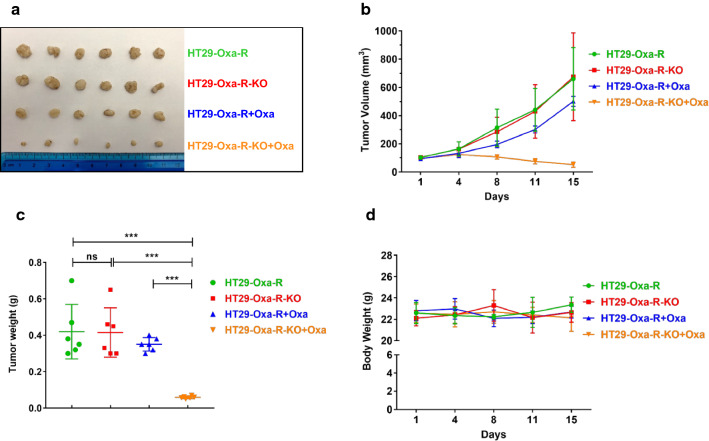
Background
The HT-29 cell line was isolated from a 44-year-old woman in 1964 by two scientists, Fogh and Trempe. HT-29 cell line have the characteristics of mature intestinal cells. When HT-29 exists in different culture conditions or inducers, the cells will show different differentiation pathways. Therefore, HT-29 cells are a model for the study of the molecular mechanism of intestinal cell differentiation. HT-29 cells are popular in research. Ubigene also has made a deep study on HT-29 cells’ culture system and gene knockout system, and Ubigene can achieve 100% protein knockout in HT-29 cells.
Applications of HT-29 cell line
So far, HT-29 cells are used in various basic researches and biomedical studies, involving lung cancer proliferation, corresponding inhibitor research, tumor formation, metastasis, and so on.
(1) Studying new synthetic drugs in the biomedical field: For example:HT-29 cells were used as a model to study the cytotoxic mechanism of polyphenol stabilized colloidal gold nanoparticles prepared from the Abutilon Indicum leaves on colon cancer cells (HT-29)[1]。
(2) Research of food industrial residues:For example, using fruit juice production residues as natural anti colon cancer drugs, studies have found that fruit juice production residues can effectively inhibit the cell proliferation of HT-29 cells and induce cell cycle arrest at different arrest points G1, G2 / M and S[2],This research has a certain role in promoting the research and development of anti colon cancer drugs.
(3) Completing the molecular mechanism of colorectal cancer formation:For example, prolyl 4-hydroxylase, βPeptide (p4HB) is related to the occurrence of colon cancer. The release of p4HB knockdown reduced the activation of the signal converter and transcription activator 3 (STAT3), and promoted the accumulation of ROS, and then induced apoptosis of HT-29 cells[3]。
(4) Study on the effect of natural fermentation products on colon cancer cells:For example, it was found that after the treatment of a natural fermentation product Lactobacillus Acidophilus CICC 6074 S-layer protein, there were chromatin condensation, nuclear fragmentation, vacuoles, and other apoptotic characteristics in the cells. This protein may induce HT-29 cell apoptosis through the death receptor apoptosis pathway and mitochondrial pathway, and inhibit cell invasion by inhibiting the synthesis of the PI3K/AKT pathway and FasL pathway[4]。
The Application of CRISPR/Cas9 Technology in HT-29 Cell
Line
CRISPR/Cas9 technology is a highly specific method for gene editing. This technology can induce sequence deletion, insertion, and point mutation in the cell. dCas9 can block transcription and inhibit gene expression. CRISPR/Cas9 technology has also been widely used in HT-29 cells. For example, p38γ is a new cyclin-dependent kinase (CDK), it found that in HT-29 cells and primary human colon cancer cells, shRNA induced p38γ silencing or CRISPR/Cas9 mediated p38γ knockout inhibited cell growth, proliferation, and migration, and significantly induced cell apoptosis[7]。
The following is a case of CRISPR/Cas9 technology in colorectal cancer cell resistance mechanism research[8],which is convenient for you to develop new ideas.Drug therapy is a way of colorectal cancer treatment, but continuous use of drugs can cause resistance of colorectal cancer cells. 5-Fluorouracil (5-FU) is an artificial nucleotide analog. Since the 1950s, it has been the main drug for chemotherapy in CRC patients, mainly by inhibiting thymidylate synthase and incorporating its metabolites into DNA, leading to cell death. In addition, oxaliplatin can also be used in the treatment of colorectal cancer patients, which belongs to the third generation of platinum drugs and can form platinum DNA complex to induce cytotoxicity.
Jinming Yu et.al established HT-29 and SW480 drug-resistant cell lines by long-term treatment with 5-FU and oxaliplatin, respectively.Western blot analysis showed that REV7( Translation synthesis polymerase ζ( POL ζ) key components of) was up-regulated in 5-FU and oxaliplatin resistant CRC cells (Fig. 1. A-D), REV7 in HT-29 and SW480 also increased in a dose-dependent manner (Fig. 1. E-H). But the interesting thing is that there was no significant difference in the expression of REV7 mRNA after treatment, which means that the increase of REV7 protein was not caused by the change of transcription level.

Fig 1.
Jinming Yu et al. used CRISPR/Cas9 technology to specifically target the REV7 gene. Under drug treatment, REV7 was almost not expressed in REV7 deficient cell lines (Fig. 2. a-b). Plasma-based TLS efficiency analysis showed that the deletion of REV7 significantly inhibited the TLS (translesion synthesis) efficiency in drug-resistant HT-29 cells, and this phenomenon was alleviated after the supplement of REV7 (Fig. 2. c-d).

Fig 2.
It was found that the expression of REV7 did not affect the tumor volume without drug stimulation in mice xenotransplantation of drug-resistant cell lines, indicating that REV7 did not affect the occurrence of colorectal cancer. When given drug stimulation, the absence of REV7 significantly inhibited tumor growth, but there was no significant difference in individual weight (Fig. 3).

Fig 3.
In conclusion, HT-29 cell line as a classic cancer cell model are very important for the study of colorectal cancer, and CRISPR/Cas9 also plays a very important role in molecular research methods. So far, Ubigene has used CRISPR-U ™ technology to successfully modified genes from more than 100 cell lines, including the HT-29 cell line. And Ubigene provides gene-editing services worldwide. Now Ubigene has time-limited discount of all gene-editing services: KO cell line service, as low as 3780 USD、KI/Point mutation cell line service, as low as 8480 USD、gRNA plasmids, as low as 80 USD
References:
[1]Sadras Sudha Rani, et al. Polyphenol stabilized colloidal gold nanoparticles from Abutilon indicum leaf extract induce apoptosis in HT-29 colon cancer cells[J]. Colloids Surf B Biointerfaces, 2016, 143: 499-510.
[2]Catarina M.M.Duarte, et al. Evaluation of Opuntia spp. derived products as antiproliferative agents in human colon cancer cell line (HT29)[J]. Food Research International, 2013, 54: 892-901.
[3]Zhang Qilin, et al. P4HB knockdown induces human HT29 colon cancer cell apoptosis through the generation of reactive oxygen species and inactivation of STAT3 signaling[J] .Mol Med Rep, 2019, 19: 231-237.
[4]Yuxing Guo, et al. Effect of Lactobacillus acidophilus CICC 6074 S-Layer Protein on Colon Cancer HT-29 Cell Proliferation and Apoptosis[J]. J Agric Food Chem, 2020, 68: 2639-2647.
[5]Yaguang Xi, et al. CRISPR/cas9, a novel genomic tool to knock down microRNA in vitro and in vivo[J]. Sci Rep, 2016, 6: 22312.
[6]Jinke Wang,et al. Cancer gene therapy by NF-κB-activated cancer cell-specific expression of CRISPR/Cas9 targeting to telomere. doi: https://doi.org/10.1101/553099
[7]Yiou Cao, et al. Targeting p38γ to inhibit human colorectal cancer cell progression[J].Biochem Biophys Res Commun. 2019 Sep 10;517(1):172-179. doi: 10.1016/j.bbrc.2019.07.038.
[8]Jinming Yu, et al. Targeting REV7 effectively reverses 5-FU and oxaliplatin resistance in colorectal cancer[J].Cancer Cell Int, 2020, 20: 580.

No comments:
Post a Comment